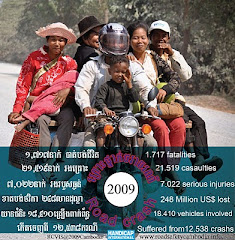Road crashes are now the leading cause of death worldwide for children and young people aged between ten and twenty-four. Somebody is killed or seriously injured on the world’s roads every six seconds. Annually at least 1.2 million people die and 50 million are injured, a scale of death
comparable with malaria or tuberculosis.
More than 85% of casualties occur in low and middle income countries. Africa has the world’s highest death rate per population, but South East Asia is experiencing the highest number of actual fatalities and injuries and is facing the highest predicted growth in road traffic injuries.
Road traffic deaths and injuries impose a huge economic burden on developing economies, amounting to 1-2% of GNP in most countries. These costs, some $64.5 billion - $100 billion per annum, are comparable with the total bilateral overseas aid contributed by the industrialised
countries, which amounted to $103.9 billion in 2006. These estimates take account only of the direct economic costs – mainly lost productivity – rather than the full social costs often recognised by industrialised countries.
Worldwide, more than half of road traffic casualties are in the 15-44 age group, the key wage earning and child raising group. In Kenya, for example, more than 75% of road traffic casualties are amongst economically active young adults. The loss of the main wage earner and head
of household due to death or disability can be disastrous, leading to lower living standards and poverty, in addition to the human cost of bereavement.
Road traffic crashes can also disproportionately affect the poorest groups in society. In low and middle income countries poor people are usually vulnerable road users (pedestrians, cyclists and motorcyclists). They are at particular risk from the greater variety and intensity of traffic mix
and the lack of separation from other road users. In Kenya, pedestrians and passengers in mass transit accounted for 80% of all fatalities, and in Mumbai, India, 78% of road fatalities
were pedestrians. As vulnerable road users, children are at particular risk. Children in low and middle income countries are much more likely than children in high income countries to be
involved in a road crash. In South Africa, for example, more than 26 child deaths per 100,000 population occur as a result of road traffic crashes, compared to 1.7 per 100,000
population in the EU as a whole.
 Overall 96% of child road fatalities occur in low and middle income countries. The World Health
Overall 96% of child road fatalities occur in low and middle income countries. The World HealthOrganization predicts that by 2015 deaths and injuries on the roads will top its DALYS league
(healthy life years lost through death and disability) for children aged four and above in developing countries. To provide a clear framework for global action to promote road safety, the World Health Organization and the World Bank published, in 2004, the World Report on road traffic injury prevention. The first ever comprehensive global overview of the magnitude, risk factors and impact of road traffic injuries, the World Report has contributed powerfully to the case for action on global road safety. Involving over 100 experts, from all continents and different sectors, the World Report offered six key recommendations as flexible guidelines that governments should follow:
1. Identify a lead agency in government to guide the national road traffic safety effort;
2. Assess the problem, policies and institutional settings relating to road traffic injury
and the capacity for road traffic injury prevention in each country;
3. Prepare a national road safety strategy and plan of action;
4. Allocate financial and human resources to address the problem;
5. Implement specific actions to prevent road traffic crashes, minimise injuries and their
consequences and evaluate the impact of these actions;
6. Support the development of national capacity and international cooperation.
Recognising that not all low and middle income countries would be able to take all these recommendations forward with their own resources, the Report suggested that countries should
work with international or non-governmental organisations or other partners to implement
the recommendations. In 2005 the FIA Foundation, which co-funded the World Report, established the Commission for Global Road Safety, under the chairmanship of former NATO Secretary General Lord Robertson of Port Ellen, to examine how the international
community is responding and should respond to the global road safety crisis. The Commission’s report, Make Roads Safe: a new priority for sustainable development makes a number of proposals for raising the political profile of road safety and securing sustainable funding to enable implementation of the recommendations of the World Report on road traffic injury prevention.



No comments:
Post a Comment